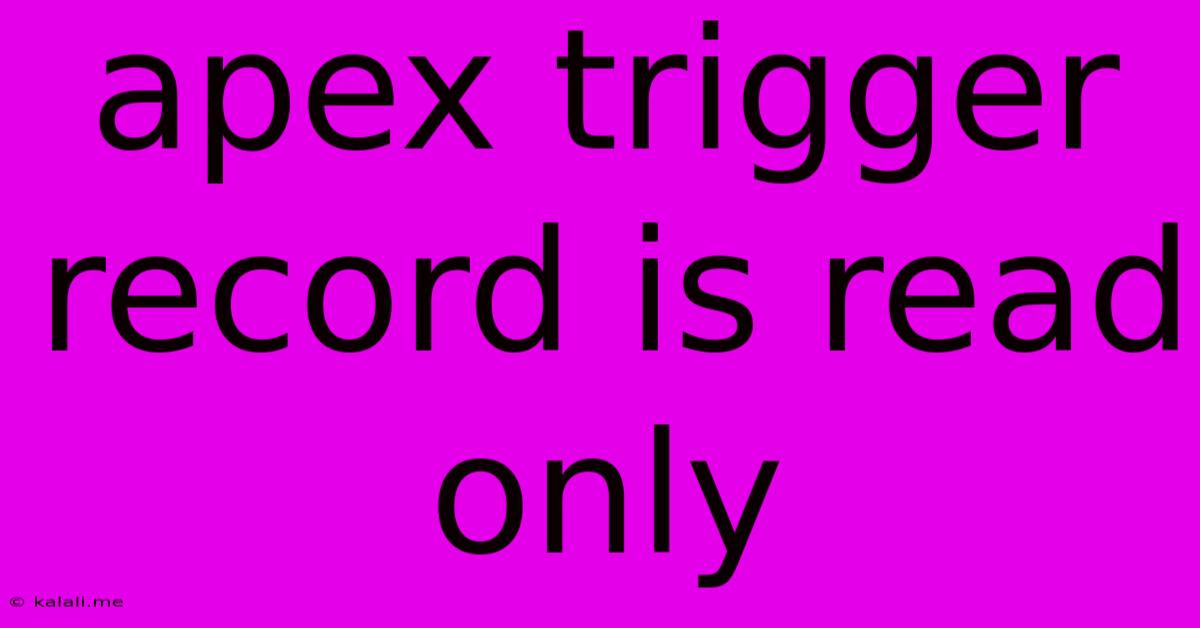Apex Trigger Record Is Read Only
Kalali
May 23, 2025 · 3 min read

Table of Contents
Apex Trigger: Understanding and Working with Read-Only Records
Understanding how records behave within Apex triggers is crucial for building robust and efficient Salesforce applications. A common point of confusion, especially for developers new to the platform, is the read-only nature of records within before triggers. This article will delve into why records are read-only in before triggers, the implications this has for your code, and best practices for working effectively within these constraints.
What this article covers: This guide explains the read-only nature of records in Apex before triggers, explores the consequences of attempting to modify them, outlines alternative solutions, and emphasizes best practices for working with data within trigger contexts. This understanding is crucial for building robust and error-free Salesforce applications.
Why are Records Read-Only in Before Triggers?
In Salesforce Apex, before triggers execute before a record is inserted or updated. The primary reason records are read-only in this context is to maintain data consistency and prevent unexpected behavior. Imagine if you could directly modify a record within a before trigger – this could lead to infinite loops, data corruption, and unpredictable results. Salesforce's design ensures that the changes made within the before trigger context are properly handled and applied only after the trigger completes its execution. This controlled approach safeguards data integrity.
Implications of Read-Only Records
Attempting to directly modify a record's fields within a before trigger will result in an error. The platform will throw an exception, indicating that the record is read-only. This prevents developers from unintentionally altering data in ways that could compromise data consistency or lead to unexpected application behavior. Therefore, understanding this limitation is essential for writing correct and efficient Apex code.
Working with Read-Only Records: Best Practices
Since you can't directly modify fields, you need alternative approaches to manage data within before triggers. Here are some best practices:
-
Utilize the
newList: Forbefore insertandbefore updatetriggers, thenewlist contains the records being processed. Instead of directly modifying the records in thenewlist, you can modify the values within this list. These changes will then be reflected in the database after the trigger completes. -
Employ Custom Variables: Create temporary variables to store modified values. Then, update the corresponding fields in the
newlist using these temporary variables. This approach keeps your code clean and easy to maintain. -
Proper Error Handling: Always include robust error handling in your trigger code. Wrap your logic in a
try-catchblock to gracefully handle exceptions and prevent unexpected application failures. This is especially important when working with external APIs or complex logic. -
Use
beforeandafterTriggers Strategically: Complex logic may require a combination ofbeforeandaftertriggers. For example, you can perform validations in thebeforetrigger and then perform related updates or calculations in theaftertrigger using the updated records. This separation of concerns improves code readability and maintainability.
Example: Updating a Related Field in a Before Trigger
Let's consider a scenario where you need to update a related field based on the values of other fields in a before update trigger. You cannot directly modify the record in the before trigger, so you need to leverage the new list and careful assignments:
trigger MyTrigger on MyObject__c (before update) {
for (MyObject__c record : Trigger.new) {
if (record.FieldA__c != null && record.FieldB__c != null) {
record.RelatedField__c = record.FieldA__c + record.FieldB__c; //Updates in the new list, not directly on the record.
}
}
}
This example demonstrates how to indirectly modify a field using the new list without violating the read-only constraint. Remember to always prioritize efficient and clean code when working with Apex triggers.
Conclusion
Understanding the read-only nature of records in Apex before triggers is critical for developing reliable and efficient Salesforce applications. By using techniques like modifying the new list and employing appropriate error handling, developers can overcome this constraint and build robust solutions that maintain data integrity. Remember to strategically plan your trigger logic using both before and after contexts for complex scenarios. This approach ensures your code remains maintainable and scalable.
Latest Posts
Latest Posts
-
How Many Tablespoons Are In A Hidden Valley Ranch Packet
Jul 10, 2025
-
Which Is The Best Summary Of The Passage
Jul 10, 2025
-
How Many Quarts Of Soil In A Cubic Foot
Jul 10, 2025
-
What Is 3 4 Of A Pound
Jul 10, 2025
-
How To Measure 1 8 Teaspoon With 1 4 Teaspoon
Jul 10, 2025
Related Post
Thank you for visiting our website which covers about Apex Trigger Record Is Read Only . We hope the information provided has been useful to you. Feel free to contact us if you have any questions or need further assistance. See you next time and don't miss to bookmark.